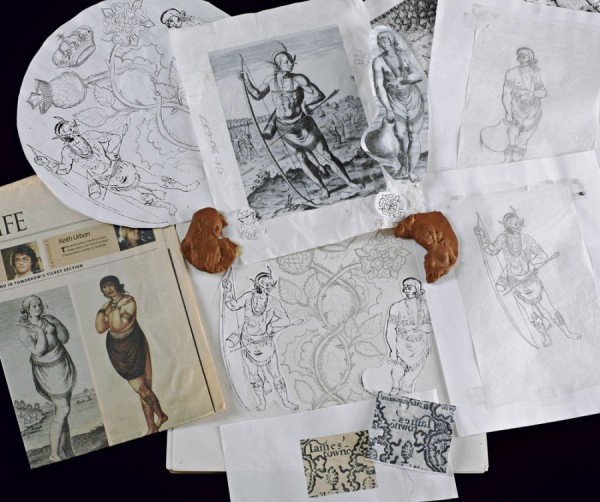
Source material, conceptual renderings, and clay models for Queen Elizabeth’s 2007 commemorative gift. (Courtesy, Michelle Erickson; photos, Gavin Ashworth, unless otherwise noted.)
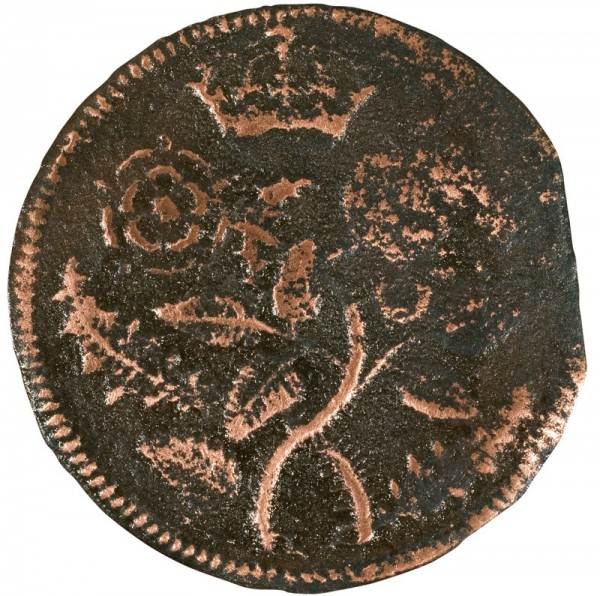
Token, London, ca. 1603–1610. Copper alloy. D. 1 1/8". (Courtesy, Jamestown Rediscovery, Association for the Preservation of Virginia Antiquities.)
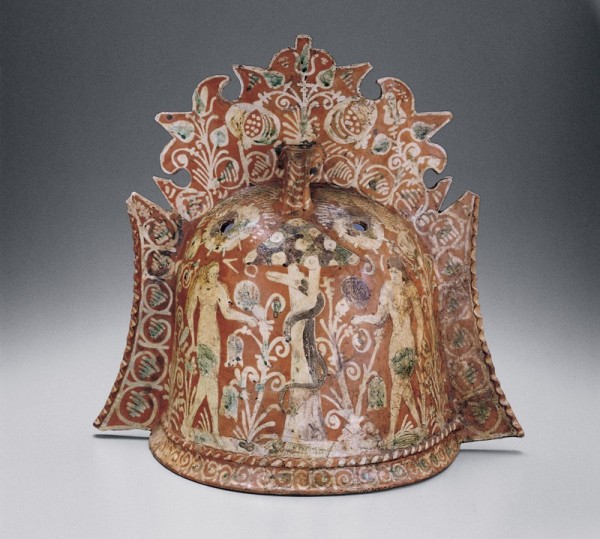
Curfew (firecover), The Netherlands, 1607. Slipware. H. 15 5/8". (Private collection.) These elaborately decorated slipware devices were used to cover smoldering embers on Dutch hearths.
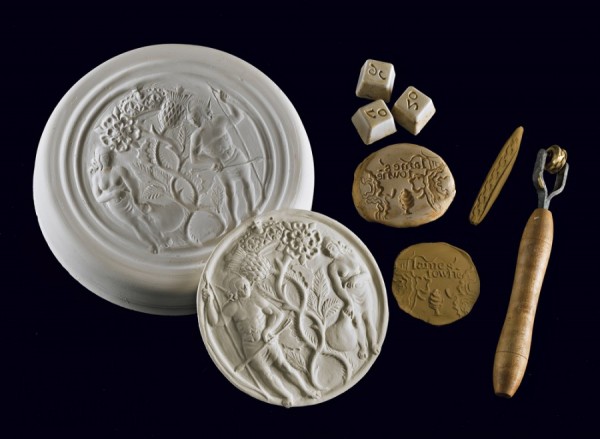
Maquette and related hand-carved sprig molds and roulette wheel. D. of mold 8 1/4". (Courtesy, Michelle Erickson.) This smaller prototype helped refine the larger medallion. Note the smaller molds for the dates and the “Iames towne” lettering. The wood-handled brass roulette was used to emboss the rim of the medallion, a sample of which is shown in raw clay.

Original clay model, Michelle Erickson, Virginia, 2006. Porcelain clay. D. 14".

Plaster mold, Michelle Erickson, Virginia, 2006. D. 15 3/4".
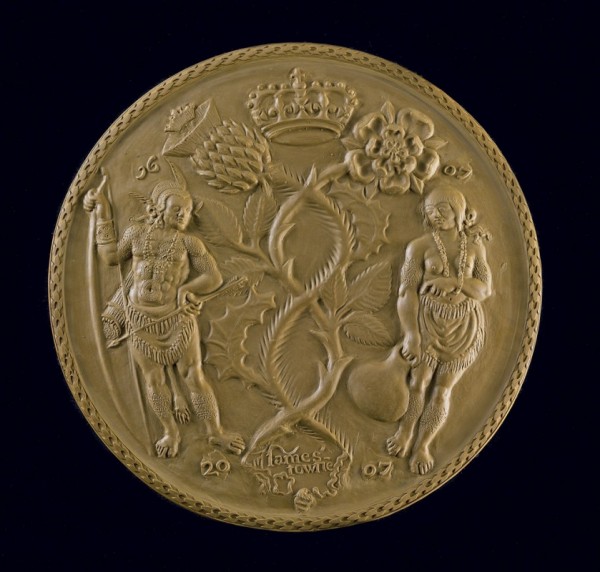
Raw clay medallion, Michelle Erickson, Virginia, 2007. D. 12". The medallion was made with indigenous Virginia clay.

Medallion, Michelle Erickson, Virginia, 2007. Stoneware. D. 10 1/2". Shown here is the medallion after high-temperature firing.
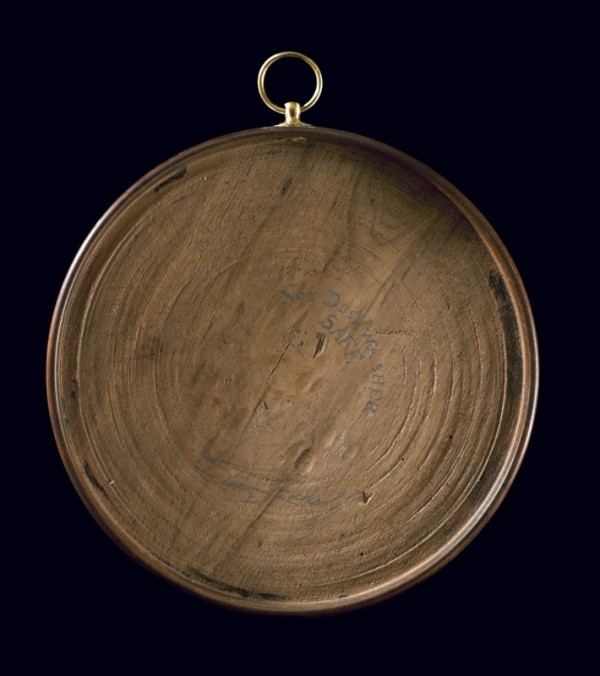
Frame, Steve Lalioff, Indiana. Walnut and brass. D. 11".

Framed medallion presented to Queen Elizabeth II on May 4, 2007.
The King was in his counting-house
Counting out his money;
The Queen was in the parlour
Eating bread and honey. . .
—“Sing a Song of Sixpence,” English nursery rhyme, 18th century
King or queen, money or honey; down through the centuries it has been the privilege of monarchs to milk their subjects. English medieval and Tudor kings and queens made annual “progresses” around the country, bestowing their presence on the nobility and expecting costly gifts that many could ill afford. The hosts, if lucky, garnered royal favors while the monarch enriched his private treasury. The prospect of a royal visit could send fearful shudders through the chosen families stuck to provide bread and honey to the visiting royals and their hundreds of hungry retainers.
Fortunately, the rules have changed. In Britain the monarch no longer gets to keep the goodies, each being considered a gift to the inanimate Crown as the symbol of the nation. Even so, a royal visit at home or abroad still involves both money and honey—as well as appropriate gifts. Her Majesty Queen Elizabeth II’s visit to Virginia in 2007 was no exception. As the visit was in honor of the four-hundredth anniversary of the founding of Jamestown, each of the hosting organizations had to give her something. But what?
Colonial Williamsburg, which had no connection with early-seventeenth-century Jamestown, settled on a reproduction of an English silver saffron pot from 1737/38 and a book of modern essays about the Jamestown era, handsomely bound in colonial-style leather.[1] In truth Colonial Williamsburg has a long history of gift-giving to visiting notables and so the selection did not call for prolonged debate.[2] The Jamestown-Yorktown Foundation, on the other hand, had to think harder and decided on a reproduction of a German stoneware mug from its collection that is reputed to have been given by James I’s Queen Anne to the Indian princess Pocahontas. Although topped with a thin silver rim, as a gift from one monarch to the daughter of another such a mug would have been almost insultingly trivial. Nevertheless, it is “of the period.”[3]
The state’s Jamestown 2007 planners had no collection from which to draw and so turned to internationally renowned potter Michelle Erickson of Hampton, Virginia. The organization’s executive director, Jeanne Zeidler, thus had found an easy out: Let Michelle come up with something, she decided. But, once again, the question was what?
What would the queen like? The frank answer, had she been willing to give it, would have been “Nothing.” For the queen’s staff, receiving and exchanging gifts generates logistical nightmares. She graciously receives whatever it is and says a few words of thanks before handing the gift to a member of her entourage, who is thereupon stuck with it through the rest of the tour. Even when the object is relatively small and light, to be of presentation quality its container must not be. Colonial Williamsburg’s saffron pot was only three inches high, but its walnut chest with brass hinges and brass feet made toting it an awkward, two-handed task. An embassy officer confided that he wished people would stick to giving flowers, but added that protocol would not allow it.
Although Michelle is more than capable of making anything—from crude, Jamestown-era pots for the New World movie to the finest porcelain—her international reputation is built on originality that sometimes translates into hugely complicated works of art that are as fragile as they are delicate. Clearly something that would shatter into a hundred sherds if inadvertently dropped would not be right for this occasion. Then again, her famed delftware dishes, cups, and bowls, though copies of seventeenth-century rarities, would seem pedestrian even if decorated with Jamestown’s ships or John Smith leering at Pocahontas. Her slipwares, too, though much praised and sought after by collectors, would not be right to be received into the queen’s gloved hands. No, something unique was needed, something inspirational—but not bulky. Flat, maybe?
Potters through the ages have been prone to bulk. Inevitably the wheel coaxed the thrower toward the satisfaction of height and, as every novice potter knew, skill was expressed in terms of size. In early-seventeenth-century England throwing a big, lead-glazed jug was about as grand as one got. It fell to Dutch and Flemish immigrants to develop the English delftware industry that put both color and pictures onto middle-class dinner tables. For anything more artistically accomplished, one had to look to Europe or beyond. In short, for Michelle, English precedents and inspirations were in short supply.
In the eighteenth century, when Josiah Wedgwood recognized the need to come up with something new and different he bypassed English ceramic traditions and limitations by turning to the classical world for inspiration.[4] He is known to have admired the Romans’ high-gloss redware bowls known as terra sigillata—which translates as earthenware adorned with little figures.[5] Those were not thrown but initially press-cast in molds before being finished on the wheel. Were Michelle to go that route something in red earthenware molded with embossed figures could have merit. If the end product were to be a relief-decorated picture rather than a bowl, it would have to be hung to be appreciated. It would also be relatively light—and flat.
In medieval and Renaissance Europe highly skilled maiolica painters applied their art to dishes intended for display as much as for table use. The same became true in England after delftware began to be made, and hutches and shelves were designed to array one’s silver, pewter, and delft chargers. But because those dishes were as much as three inches deep, it fell to delftware tile makers to create decorative panels for wall suspension or, in the case of apothecary shops, to hang as signs in the windows. But delftware, even at its best, was down market, and not until the Age of Wedgwood did earthenwares become gentrified to the point of meriting wall space in the form of plaques and medallions in black basalts, jasper, and the yellow body he chose to call “Queen’s Ware.” To create them Wedgwood employed two highly skilled artists, one a Frenchman, John Voyez (ca. 1735–1800), who let bottles intrude on his creativity, and another, the sober John Flaxman (1755–1826), the son of a molder of plaster casts, who between 1775 and 1787 created reliefs for Wedgwood’s superb jasper portrait medallions.[6] Wedgwood also produced the red stoneware originally developed by David Elers, although he admitted that it never equaled the Elers products. He named it rosso antico, possibly as a salute to the Roman terra sigillata.
In sum, there was eighteenth-century precedent for Michelle to create a redware plaque or large medallion decorated in relief with historical figures. Like Flaxman and many another before her, Michelle began with sketches to place the chosen elements in propinquitous relationship to each other—which is a pompous way of saying pleasingly close (fig. 1). The central device of the entwined stems of the rose of England and the thistle of Scotland was inspired by an artifact excavated at Jamestown, namely a copper alloy “King’s Touch” token reputedly given to recipients of the king’s healing blessing (fig. 2).[7] Topped by an English crown, these elements epitomized both the colony and the unification of England and Scotland at the accession in 1603 of Scotland’s James VI to the English throne as James I.
The token was found in a cellar within the Jamestown fort in a context of circa 1608–1610 and so was of the right period to have its design incorporated into Michelle’s plaque. But how, I wondered, did Jamestown curator Bly Straube come up with the “King’s Touch” identification? Always ready to share her knowledge even when challenged, Bly gave me her source: In 1940, after a quantity of these tokens was discovered in a Piscataway Indian ossuary, a now-unidentified curator in the British Museum’s Department of Coins and Medals “reported that they were issued between 1630 and 1640 in the reign of Charles I and that they were used as admission pieces to the ceremony of the King’s Touch.”[8] That, therefore, became the conventional wisdom when, in later decades, other examples were found in Virginia.
If you have been following me with a critical eye, you will have noticed that something is wrong. If the Jamestown token was lost about 1610, how could others date from the reign of Charles I? It is my belief that the thistle-and-rose tokens had nothing to do with the “King’s Touch” but were cheaply (and one-sidedly) stamped out to throw to the London crowds at the accession or coronation of James I in 1603–1604. When the supply proved to have outstripped the demand, the remainder were obtained by the Virginia Company and shipped out to the colony as trade copper. However, as Michelle’s inspiration came from the design and owed nothing to the token’s original purpose, all that matters is that it reached Jamestown in the first years of the fort’s existence.
In 1607, when the first colonists arrived in the Powhatan River, they renamed it the James; thus on the plaque that date is divided to left and right of the emblems. This separation of the digits was frequently employed by mold makers decorating German stonewares for the English market as well as by the designers of firebacks cast by seventeenth-century English iron founders.[9]
However, it was not from the back of the fireplace but from the front that Michelle drew her most dramatic features (fig. 3). A Dutch, lead-glazed curfew (hearth hood) of 1607 is slip-decorated with figures of Adam and Eve translated into male and female Algonquin Indians—the possessors of the land into which the thorny rose and thistle intruded.[10] The figures are perhaps the most famous of all early Indian images, having been drawn by English artist John White in the summer of 1585.[11] He described the male as being representative of “their attire and painting them selves when they goe to their generall huntings or at theire Solumne Feasts.” The female held a gourd bottle and was identified by White as “A cheife Herowans wyfe of Pomeoc.” These striking figures were copied and published in 1590 by Dutch engraver Theodor de Bry to illustrate Thomas Hariot’s A briefe and true report of the new found land of Virginia, at which time he reversed the facing direction of the warrior and made several changes that included putting an arrow rather awkwardly into his left hand. De Bry identified him as “A weroan or great Lorde of Virginia.”[12] Following the engraver’s precedent, Michelle was free to make minor changes of her own: putting the gourd in the woman’s right hand, omitting her necklace, and turning her to the left, all modifications that enhanced the beauty of the composition.
Although not part of Michelle’s original porcelain design, the name Jamestown or, rather, “Iames towne” needed to be included, as did the 2007 date. These, therefore, were added at the foot of the previously pristine design, the name surrounded by small details symbolizing the James River and the colonists’ environment (fig. 4). That done, Michelle created a woven rim ornament inspired by the border to Theodor de Bry’s 1590 map of Virginia.
To this point, the queen’s gift was still an idea expressed in pencil, but to Michelle’s eye the design was standing out in relief from the paper—or it would be once she had thrown herself a fourteen-inch disk in white porcelain clay and onto which, when in the leather-hard state, she had traced her drawing (fig. 5).[13] Next she carved away the clay around the Indians and other elements so that they stood out in low relief. To this base she applied more clay to create the contours of the figures, each individually sculpted to reproduce the appearance of the sixteenth-century originals. Michelle then made a plaster cast from the now relief-decorated porcelain plaque and used that to press-mold the copies (fig. 6). With those, too, in their leather-hard stage, she then added the fine details that could not have remained sharp in the mold. To that extent, therefore, each plaque became an individual work of art. It was then fired to bisque and subsequently to the higher temperature needed to create the desired dense surface and color.
The original model in porcelain clay was stunningly beautiful in its own right, but porcelain was by no means common in 1607. Much more appropriate would be a red-firing local Virginia clay, but the question was whether it could lend itself to create a flat disk without fear of warping. The chosen clay came from the banks of the Chickahominy River, the resource used by the Virginia tribes for generations and similar to the beds later used by the colonists’ own potters. Thus the clay provided the same link between the Native American past and the future Commonwealth of Virginia as did Michelle’s ocean-spanning design (fig. 7).
The finished plaque, although fired to a relatively high temperature, remained fragile and vulnerable to edge damage (fig. 8). The necessary protection and, indeed, visual enhancement, was provided by craftsman Stephen Lalioff, who nestled it within a hand-turned walnut frame topped with a period-style suspension ring of the kind that could have been tied to a regal ribbon (fig. 9).
Sadly but perhaps inevitably Michelle was not asked to be present when her creation was handed to Her Majesty by Virginia Senator Thomas Norment, but she was gratified that, without prompting, the queen had recognized and remarked on the appropriateness of her Adam and Eve inspiration.
The Jamestown 2007 committee had asked for five copies to be cast, one of which was given to President Bush and another to Justice Sandra Day O’Connor, who, it is said, hung it in her office. Michelle’s greatest satisfaction came in a letter from Christopher Geidt, deputy private secretary to the queen, who explained that “although the many gifts which the Queen has received over the years cannot possibly all be displayed, you might wish to know that your plaque is presently on view within Buckingham Palace in a place where it is widely admired” (fig. 10). He added that the letter came “with Her Majesty’s congratulations upon your beautiful piece of work together with her warm good wishes.”
As lines from my opening nursery rhyme declare, Michelle’s plaque was, indeed, “a dainty dish to set before the Queen.”
There being no accommodation at Jamestown, the queen was staying at the Williamsburg Inn. A luncheon at the Governor’s Palace was suggested as an appropriate venue for presenting the plaque that is the subject of this article.
The Association for the Preservation of Virginia Antiquities gave the queen a reproduction of a pewter flagon found in a Jamestown well; the National Park Service gave her something made at the Jamestown Glass House.
The mount is crudely scratched with the initials “TMR,” which have been interpreted to be those of Thomas and Matoaka Rolfe. In the Booten Hall portrait of Pocahontas (now in the National Portrait Gallery, Washington, D.C.), John is incorrectly identified as Thomas. The error may have been the product of an inept and historically challenged restorer.
Not all connoisseurs share the same taste. In A Guide to the English Pottery and Porcelain in the Department of British and Mediaeval Antiquities (London: The Museum, 1904), M. L. Hobson observes that “though we may feel scant enthusiasm for the pseudo-classic art of the period” one must admire Wedgwood’s spirit (p. 66).
The process of obtaining the red gloss, known as “peptization,” was described by the late Robert Charleston in his book Roman Pottery (London: Faber and Faber, 1955), pp. 5–6.
Among Flaxman’s portraits were those of Captain Cook, Sarah Siddons, and William Pitt. Many others were made under Wedgwood’s aegis, including jasper medallions of George III and Queen Charlotte.
Scrofula (tuberculosis of the lymph nodes), known as the “King’s Evil,” was believed to be cured by the touch of a royal hand, a practice that has been traced back to the reign of Edward III (1327–1377) and continued in England and France into the eighteenth century. Recipients were given a gold coin or medal bearing the figure of an angel on the obverse and a ship on the reverse. Such coins were therefore known as angels. To discourage second-time applicants, people wishing to be touched had first to be approved by the “Sergeant-Surgeon,” who issued them a token to be presented upon entering the hall. It has been suggested, therefore, that the base-metal Jamestown token was one such door opener. James I’s biographer Arthur Wilson (The History of Great Britain: Being the Life and Reign of King James the First . . . [1653]), however, admitted that the king did not believe in the efficacy of his cure. He knew it “to be a device to ingrandize the Vertue of Kings when miracles were in fashion, though he smiled at it, in his own Reason, finding the strength of the Imagination a more powerful Agent in the Cure than the Plaisters his Chirurgions prescribed for the sore.” Helen Farquhar, “Touchpieces for the King’s Evil,” Part IV, British Numismatic Journal 15, n.s., 5 (1921): 141. Dr. B. J. Cook, curator of Medieval and Early Modern Coinage at the British Museum, kindly replied by email to my inquiry and agreed that “there would not be an obvious link with the Touching ceremony from the thistle and rose design alone,” adding that he has “no idea what the original purpose might be.” Personal communication, email to author, April 1, 2008.
Alice L. L. Ferguson, “An Ossuary near Piscataway Creek,” American Antiquity 6 (1940): 13.
Fragments of an iron fireback dated in this way and bearing the arms of James I was found at Martin’s Hundred in Virginia. See Ivor Noël Hume and Audrey Noël Hume, The Archaeology of Martin’s Hundred, 2 vols. (Philadelphia: University of Pennsylvania Museum of Archaeology and Anthropology; Williamsburg, Va.: Colonial Williamsburg Foundation, 2001), 2: 356, fig. 42.
A fragmentary Siegburg bottle from the Jamestown excavations retained part of a medallion bearing the figures of Adam and Eve, thus providing a Virginia precedent for the analogy.
Paul Hulton, America, 1585: The Complete Drawings of John White (London: British Museum Publications, 1984), pls. 33, 48.
Thomas Hariot, A Briefe and True Report of the New Found Land of Virginia (Charlottesville: University of Virginia Press for the Library at The Mariners’ Museum, 2007) [facsimile edition of Theodor de Bry’s 1590 colored engravings], pls. III, VIII.
The term porcelain refers to the fine clay which, before firing, lends itself to the sculpturing of fine details. In the past, some artists carved their master matrices in alabaster.
